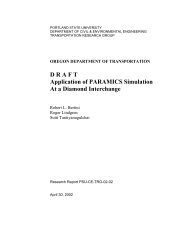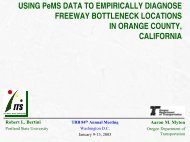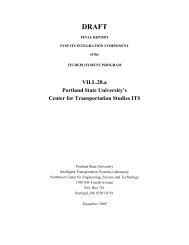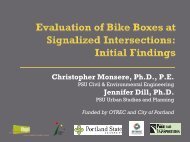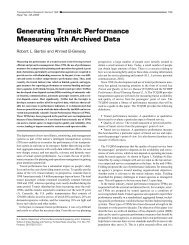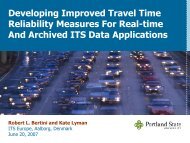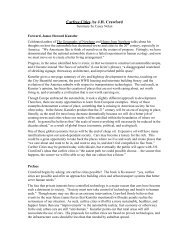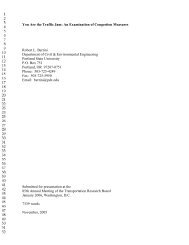Application of Paramics Simulation to a Diamond Interchange
Application of Paramics Simulation to a Diamond Interchange
Application of Paramics Simulation to a Diamond Interchange
You also want an ePaper? Increase the reach of your titles
YUMPU automatically turns print PDFs into web optimized ePapers that Google loves.
<strong>Application</strong> <strong>of</strong> PARAMICS <strong>Simulation</strong> at a <strong>Diamond</strong> <strong>Interchange</strong> Page 6<br />
Lee and Messer (8) assessed three simulation models, two microscopic (CORSIM and<br />
SimTraffic) and one macroscopic (Synchro), for diamond interchange analysis. The<br />
researchers stated that either <strong>of</strong> the microscopic models could be used for analysis <strong>of</strong> actuated<br />
diamond interchanges including those with queue spillback. The researchers suggested that a<br />
large number <strong>of</strong> simulation runs be used <strong>to</strong> produce acceptable estimates <strong>of</strong> measures <strong>of</strong><br />
effectiveness.<br />
Bloomberg and Dale (9) compared two microscopic simulation models, CORSIM and<br />
VISSIM, for a simple intersection and a congested urban network, both in Seattle,<br />
Washing<strong>to</strong>n. They concluded that both models are useful for planning and operations level<br />
analyses. They made some comparisons <strong>of</strong> the microscopic simulation results <strong>to</strong> results <strong>of</strong><br />
HCM 2000 methodology and concluded that areas with queue spill-back may not be suited<br />
for the HCM’s macroscopic modeling techniques. The authors stated that many simulation<br />
runs are required for the proper use <strong>of</strong> the model output and they encouraged future research<br />
comparing simulated results <strong>to</strong> field data.<br />
Finally, Wang and Prevedouros (10) compared two microscopic simulation models,<br />
CORSIM and WARSim, on three small urban networks, including a diamond interchange in<br />
Honolulu, Hawaii. The study networks included video surveillance equipment and freeway<br />
loop detec<strong>to</strong>rs. The authors found that ability <strong>to</strong> calibrate such measures as density and speed<br />
with “real” traffic data aided in their confidence in the results <strong>of</strong> the simulation. The authors<br />
cautioned that default parameters embedded in simulation s<strong>of</strong>tware might not always produce<br />
reasonable results.<br />
There is a growing body <strong>of</strong> research related <strong>to</strong> microscopic traffic simulation as evidenced by<br />
the number <strong>of</strong> research paper presentations on this <strong>to</strong>pic at the most recent Transportation<br />
Research Board (TRB) Annual Meeting, in January, 2002. A common theme in much <strong>of</strong> the<br />
research is the need for proper model calibration and validation. The TRB Committee on<br />
Highway Capacity and Quality <strong>of</strong> Service is considering this issue and is planning a<br />
microscopic traffic model calibration and validation workshop at their 2002 mid-year<br />
meeting.<br />
SOFTWARE DESCRIPTION<br />
PARAMICS is a microscopic urban and freeway traffic simulation s<strong>of</strong>tware suite used <strong>to</strong><br />
model the movement and behavior <strong>of</strong> individual vehicles on road networks. 1 Quads<strong>to</strong>ne<br />
along with SIAS Ltd., a private engineering consultancy also based in Edinburgh, developed<br />
a Cray supercomputer version <strong>of</strong> PARAMICS at the University <strong>of</strong> Edinburgh’s Parallel<br />
Computing Center in the early 1990’s. (11)<br />
The PARAMICS name is an acronym derived from PARAllel computer MICropic<br />
<strong>Simulation</strong>. Since 1998 Quads<strong>to</strong>ne and SIAS have developed and marketed independent<br />
versions <strong>of</strong> PARAMICS. (11) Quads<strong>to</strong>ne distributes PARAMICS outside <strong>of</strong> the United<br />
Kingdom and Ireland, whereas SIAS handles marketing within the United Kingdom and<br />
1 PARAMICS is marketed in the United States by Quads<strong>to</strong>ne Ltd. <strong>of</strong> Edinburgh, Scotland, United Kingdom.<br />
Website http://www.paramics-online.com<br />
Portland State University Transportation Research Group 2002



